There are a number of teams in the NHL preparing for the NHL Entry Draft, the free agency interview period or July 1 where spending money has become a dangerous habit for general managers. While new Edmonton Oilers GM Ken Holland may not have anything big on his agenda over the next two weeks, there are things he needs to do.
And, with growing concern about the future NHL salary cap forecast, teams may be busier than expected when it comes time to shedding salary.
Like other franchises, one of the potential options at Holland’s disposal are buyouts. This is the practice of paying fractional salaries on players over longer terms to alleviate some of the financial burdens on a team and stretch out the torture that is a poor cap hit on a specific contract.
Edmonton has a few contracts that can only be described as less-than-desirable.
The question will be, will Holland “take advantage” of this buyout practice? Or, are these contracts just not worth the trouble buying them out can cause down the road?
Like a number of Oiler scribes who are looking at this situation to see if there’s a viable option here, I’m not so sure there is.
Related: Oilers News & Rumors: Woodcroft, Gretzky, Puljujarvi, Lucic, More
** All numbers courtesy of Capfriendly.com
Milan Lucic
Remaining cap hit:
$6 million (for each of the next four seasons)
Buyout savings:
$2,375,000 (2019-20), $375,000 (2020-21), $1,875,000 (2021-22), $375,000 (2022-23), -$625,000 (2023-24 to 2026-27)
Cap hit after buyout:
$3,625,000 (2019-20), $5,625,000 (2020-21), $4,125,000 (2021-22), $5,625,000 (2022-23), $625,000 (2023-24 to 2026-27)
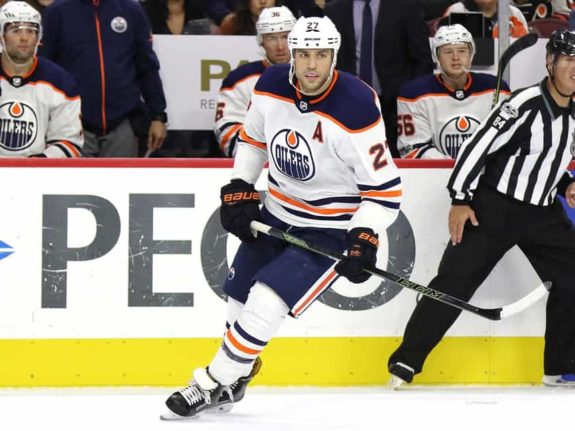
Why Would the Oilers Buy Out Milan Lucic?
If we’re being kind, Lucic has been the Edmonton Oilers’ biggest albatross contract over the past two seasons. Worse yet, there are no signs he’s figured out how to get himself out of the mental black hole he’s currently in production-wise.
It would be one thing if he offered other attributes like penalty killing or was actually playing physical but that’s not really happening either. Some have contended he brings another element beyond the scoring he’s supposed to be doing, it’s just hard to see what that is these days.
At no point is a buyout good for Edmonton when it comes to Lucic’s contract but the question remains, is the team better by sending a message and removing him from the roster regardless of the financial burden a buyout causes?
A trade would be better and there’s plenty of buzz that someone like James Neal or Loui Eriksson are options but the reality is, neither is probable.
What the Oilers Should Do
This one is easy. Lucic’s contract is virtually buyout-proof. Meant to be lockout-proof, his signing bonuses make the savings on a buyout hardly worth it. You can see in years 2020-21 and 2022-23, his cap hit is almost the same as it is now. In short, the team would be paying almost his entire salary over a good chunk of the buyout period and then the optics of stretching those payments out until 2027 is ugly.
Related: Sharks Trade Justin Braun to Flyers
Kris Russell
Remaining cap hit:
$4 million (for each of the next two seasons)
Buyout savings:
$3,083,333 (2019-20), $583,333 (2020-21), -$916,667 (2021-22 and 2022-23)
Cap hit after buyout:
$916,667 (2019-20), $3,416,667 (2020-21), $916,667 (2021-22 and 2022-23)
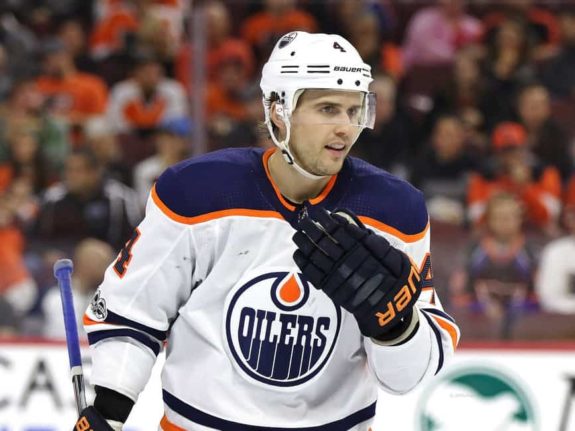
Why Would Oilers Buyout Russell?
Since the day Russell arrived, he’s been a polarizing player in Edmonton. There have been a group of fans and media who say he’s not worth anywhere close to the salary he’s making as a depth defender who blocks shots and there are others who say his contract isn’t anywhere close to the most troubling on the team.
At $4 million per season, you’d like to see more offence and if he’s playing on the bottom pair (where he probably should be) he’s overpriced. A buyout saves the Oilers quite a bit and there are probably less costly defenders out there.
What the Oilers Should Do
Buying out Russell is great for next season but not great beyond that. A signing bonus makes the 2020-21 savings almost nill. Unlike Lucic, this is not a long-term problem.
So too, a buyout assumes a trade can’t be made to move Russell. As much as he’s polarizing, his blocked shots stats will have teams interested there are GM’s out there that have spoken highly of Russell. There’s a reason the Oilers have liked him despite being technically overpaid.
The question is, if the salary cap doesn’t reach that projected $83 million figure, does this change the interest level in Russell around the league? It might.
Related: NHL Rumors: Maple Leafs, Hurricanes, Blue Jackets, More
Kyle Brodziak
Remaining cap hit:
$1.15 million (2019-20)
Buyout savings:
$800,000 (2019-20), -$400,000 (2020-21)
Cap hit after buyout:
$350,000 (2019-20), $400,000 (2020-21)
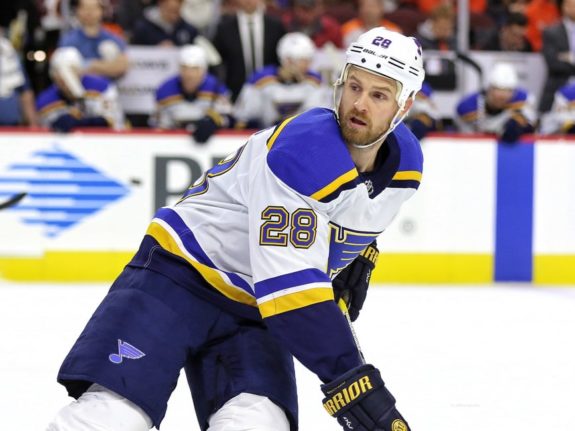
A veteran of 917 games played, Brodziak’s best days are probably behind him. He’s a depth center who was picked up to provide some leadership on a team that sorely missed it when Matt Hendricks left the team and while he didn’t provide much offensively for Edmonton in 2018-19, he’s only one season removed from a 33-point campaign with the St. Louis Blues.
Buying out Brodziak means you have a spot ready to give to someone from the minors or have brought in a player from Europe or the collegiate level to take Brodziak’s place. The Oilers haven’t really signed anyone like that this season/summer.
A penalty killer and faceoff guy, if Brodziak can provide that attribute to the team this season, he’s useful. And, at $1.5 million, you won’t grab someone out of free agency that isn’t older to take his place.
What the Oilers Should Do
Keep Brodziak. He’s not the solution, but he’s certainly not problem.
Brandon Manning
Remaining cap hit:
$2.25 million (2019-20)
Buyout savings:
$1,333,333 (2019-20), -$666,667 (2020-21)
Cap hit after buyout:
$916,667 (2019-20), $666,667 (2020-21)
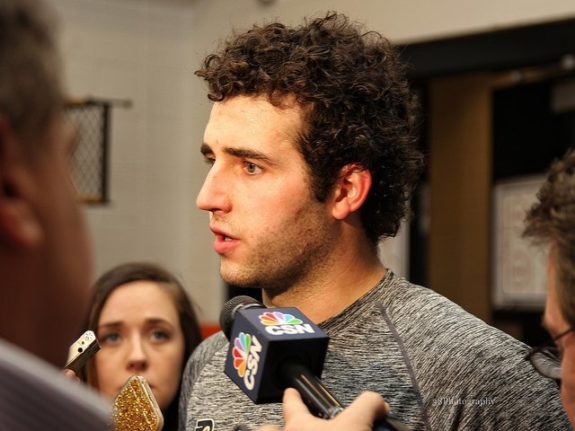
Why Would Oilers Buyout Manning?
Let’s try and look past the fact that the Manning trade was a mistake the second it happened and focus on the act of solving a problem. At $2.25 million in terms of salary, where Manning is playing in the lineup (assuming he plays at all) is where a depth defender at league minimum should be.
There are two schools of thought here. Waiving him and stapling his butt to the AHL actually costs more against the cap that buying him out does next season. Alternatively, if you believe the Oilers are not contenders next season and you want to load up in 2020-21 without the burden of his contracts on the books, waive him.
What the Oilers Should Do
This is the best-case scenario for the Oilers in terms of a buyout but it’s still not a slam dunk. I get the sense the Oilers will leave him in the AHL and take the hit this year, get him off the books after this coming season and hope they can find dirt cheap contracts and success stories on PTO’s to round out the roster and squeak into the postseason in 2020.
Sam Gagner
Remaining cap hit:
$3.15 million (2019-20)
Buyout savings:
$2,133,333 (2019-20), -$1,066,667 (2020-21)
Cap hit after buyout:
$1,016,667 (2019-20), $1,016,667 (2020-21)
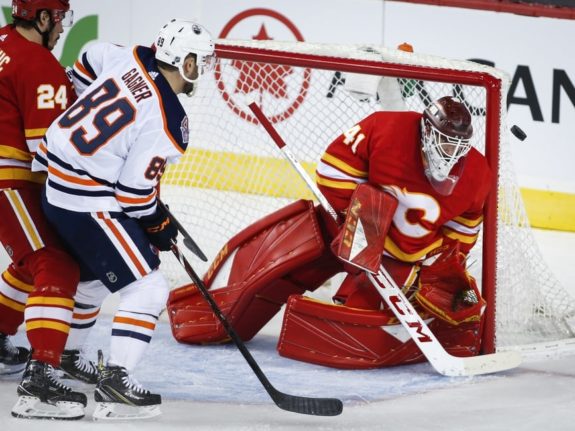
Even though Gagner’s cap hit is higher than it should be for the likely production he’ll provide, there’s still a chance he does better than most people expect if given an elevated role with the Oilers next season. He’s still a player who feels he has something to prove and in 25 games for the Oilers last season, he scored five goals and five assists for 10 points.
His buyout savings look good in year one but you have to ask yourself if his salary cap savings over the two years ($2 million) is enough to try and get another forward that will produce the same or more than Gagner will.
What the Oilers Should Do
Again, let this one sit and hope Gagner isn’t that far removed from his 50 and 31-point seasons with Columbus and Vancouver. Hope he helps you on the power play and with the right linemates can pot 40 points and 18-20 goals.
Those numbers won’t make him a steal but they won’t make him dead weight either.
Related: NHL Rumors: Oilers, Avs, Zuccarello, Trouba, More
Andrej Sekera
Remaining cap hit:
$5.5 million (for each of the next two seasons)
Buyout savings:
$3 million (2019-20 and 2020-21), -$1.5 million (2021-22 and 2022-23)
Cap hit after buyout:
$2.5 million (2019-20 and 2020-21), $1.5 million (2021-22 and 2022-23)
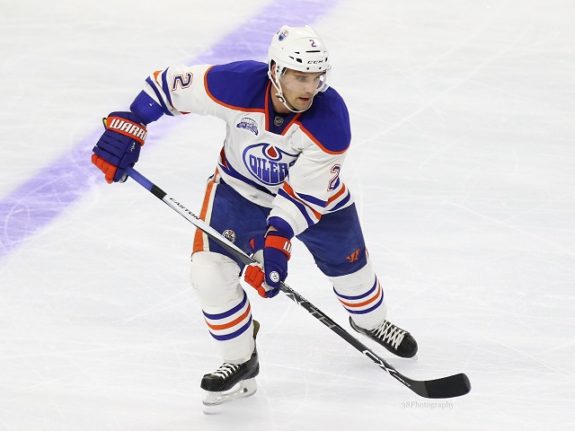
The truth is, Sekera is a serious question mark in the NHL after two major surgeries that kept him out of the league for a good chunk of the previous two seasons. At 33 years old, he may never again be the top-four defenseman he once was.
In 2017-18 he did not look good. But, at the tail end of last season, he was much improved. Which version of Andrej Sekera are the Oilers expecting to get?
He has a sizable cap hit for the next two seasons and the savings on a buyout are something that can’t be ignored. $3 million this season and $4 million the season after can help the Oilers secure talent, especially if the free agent market turns out to be a buyers market.
What the Oilers Should Do
The issue here is the length of term over which the buyout will last. A $1.5 million cap hit penalty in years 2021-22 and 2022-23 mean that if the Oilers can figure out a way to be a playoff contender under Holland’s newly built roster, that could be a player you can’t add later when you need it.
The Oilers blue line is not stable. Holland preached stability. If Sekera is one of the few players who can keep the defense core from sinking next season, you shouldn’t let that go, even if he’s overpaid.
Related: NHL Rumors: Ducks, Oilers and the NHL Trade Market
In the end, buyouts may look attractive and there are arguments to be made in a few cases on the Oilers roster. Still, the one contract the team absolutely needs to shake is the contract that is the most buyout proof in Milan Lucic.
Edmonton might just have to take their lumps for two more seasons (one in some cases) and hope that a trade can come through that alleviates the pain.